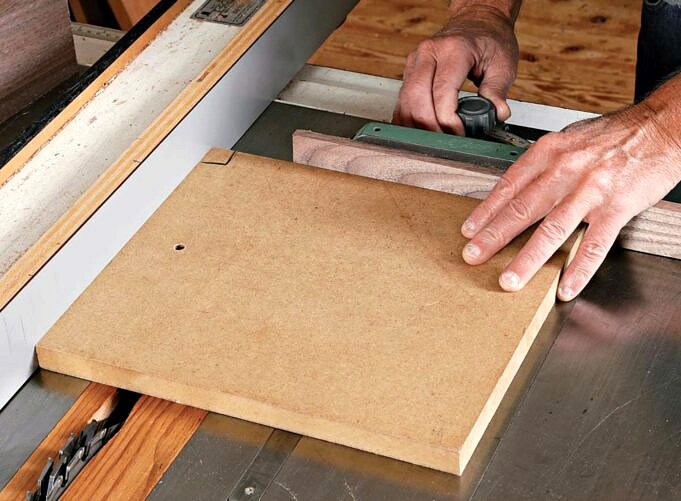A mortise and tenon are one of the strongest joints in woodworking and they can be made using a table saw.As the name suggests, its made up of two parts: A mortise and a tenon.In this guide, Ill show you how you can make this joint using a table saw.Youll learn about the different types of cuts needed for a mortise and tenon joint and then how to make them using your table saw.Youll also find out how to use a jig or template to ensure perfect results.
Lets get started!
Steps For How To Cut Mortise And Tenon On The Table Saw?
Cut The Pieces
Before starting any project, you need to decide what pieces you want to use.For our example, were going to build a small sideboard.Were making three different mortises and tenons as well as some other details.Our first step is to measure each piece and mark where we want to cut.Start by measuring the width of the board.Then measure from the edge to the center of the board.This will give you the distance between the sides of the board.Now measure the length of the board.Then add that measurement to the end of the board. This will tell you the total length of the board. These measurements are W1, L1, and W2. These measurements are W1, L1, and W2.
Make The Mortises
Start by tracing the outside edges of your boards. Next, use a ruler to place it on the lines that you made earlier.
Make Your Own Glue.
You’ll need glue that is safe to use on your child’s skin. This type of glue is called corn glue because it comes from the corn plant. Cornstarch is also used to make baby food. It is easy to use and can be found in most grocery stores. You can make your own by adding one part water to two portions cornstarch.
Step Mixing Starch With Water.
Add the cornstarch into the bowl until the mixture turns white. If necessary, add more water.
Making The Glue Safe For Kids Skin And Eyes.
Mixing cornstarch and water together will not result in bacteria entering the glue. The only thing you need to do is make sure the glue is safe for kids skin and eyes. You can do this by adding a few drops of dish soap to the glue before applying it to the surface.
Use The Glue.
Apply the glue to the surfaces you plan to attach the legs to.The best way to apply the glue is to spread it onto a paper towel or cloth. Then wipe away any excess with a damp sponge.
Clean Up The Surfaces After Applying The Glue.
After youve applied the glue, clean up the surfaces with a wet rag. Use a little bit of soap on the rag to keep the surfaces clean.
Attach The Legs.
Attach the legs to tops of boards
To ensure that they are perpendicular to each other, use a level.
Finally, drill holes for the screws.
Drill Holes Into The Boards.
Regularly drill holes in the boards.
Cut Out The Tenons.
With the help of a router, cut out the tenons.
Sand Down The Boards.
To smoothen the boards, use a sanding tool.
Tips For Accuracy While Cutting Mortise And Tenon On Table Saw
You will need to measure the mortise or tenon before you can cut them out.
Safety Tips To Cut Mortise Or Tenon On Table Saw
Safety first Always wear safety goggles while using a power tool like a table saw.Always follow the manufacturers instructions when setting up the machine.Never try to adjust the settings yourself unless you have been trained to do so.Remember to always read the owners manual thoroughly before operating the machine.If you ever feel unsure about what you are doing, contact a professional.In conclusion, we hope these steps will help you achieve accurate results when cutting mortise and tenon joints on your table saw.
FAQ,s
- Why Mortise and Tenon Joints
Mortise and tenon joints are used in furniture construction because they provide a strong joint that doesnt require gluing.They also allow for easy assembly and disassembly.
- What are the different types of Mortise or Tenon?
There are two types of mortise and tenon: butt-joint and shoulder-joint.Butt-joint mortise and tenon have a flat face that meets a flat face.Shoulder-joint mortise & tenon is angled as it goes through the material.
- Which Technique is Better?
That all depends on your own preference and personal experience.
- What is the difference between Butt-Joint Mortise, Shoulder-Joint Mortise, and Tenon Joinery
Butt-joinery has a flat surface where the tenon fits while shoulder-joint mortise has a sloping surface.
- What is the average time it takes to build a mortise?
The time required to build a mortise depends on the size of the mortise and how deep it needs to be.A small mortise can take anywhere from 30 seconds to 1 minute.A large mortise can take anywhere between 10 minutes to an hour.
For joining two pieces of wood together, both butt-joint or shoulders-joint mortise jointery can be used. - What tools are needed to make Mortise and Tenon Jigs
You dont really need special tools to make mortise and tenon jigs.But if you want to make one, then you should consider buying a router and some scrap plywood.
Conclusion
Mortises and Tenons are a common woodworking technique. We decided to share our tips on how to do it efficiently and accurately.



